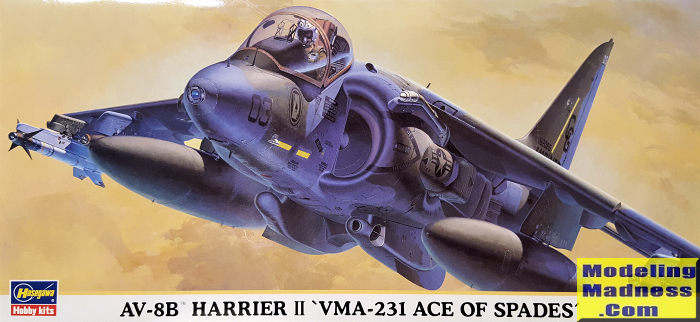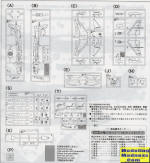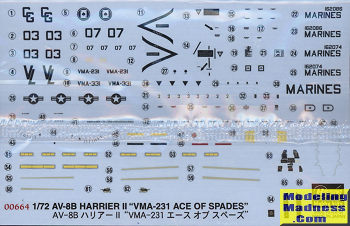
Hasegawa 1/72 AV-8B Harrier 'VMA-231 Ace of Spades'
| KIT #: | 00664 |
| PRICE: | 1400 yen SRP |
| DECALS: | Two options |
| REVIEWER: | Scott Van Aken |
| NOTES: | 2003 release |

| HISTORY |
The McDonnell Douglas (now Boeing) AV-8B Harrier II is a single-engine ground-attack aircraft that constitutes the second generation of the Harrier Jump Jet family, capable of vertical or short takeoff and landing (V/STOL). The aircraft is primarily employed on light attack or multi-role missions, ranging from close air support of ground troops to armed reconnaissance. The AV-8B is used by the United States Marine Corps (USMC), the Spanish Navy, and the Italian Navy. A variant of the AV-8B, the British Aerospace Harrier II, was developed for the British military, while another, the TAV-8B, is a dedicated two-seat trainer.
The project that eventually led to the AV-8B's creation started in the early 1970s as a cooperative effort between the United States and United Kingdom, aimed at addressing the operational inadequacies of the first-generation Hawker Siddeley Harrier. Early efforts centered on a larger, more powerful Pegasus engine to dramatically improve the capabilities of the Harrier. Because of budgetary constraints, the UK abandoned the project in 1975. Following the UK's withdrawal, McDonnell Douglas extensively redesigned the earlier AV-8A Harrier to create the AV-8B. While retaining the general layout of its predecessor, the aircraft incorporates a new, larger composite wing with an additional hardpoint on each side, an elevated cockpit, a redesigned fuselage and other structural and aerodynamic refinements. The aircraft is powered by an upgraded version of the Pegasus. The AV-8B made its maiden flight in November 1981 and entered service with the USMC in January 1985. Later upgrades added a night-attack capability and radar, resulting in the AV-8B(NA) and AV-8B Harrier II Plus versions, respectively. An enlarged version named Harrier III was also studied but not pursued. The UK, through British Aerospace, re-joined the improved Harrier project as a partner in 1981, giving it a significant work-share in the project. Following corporate mergers in the 1990s, Boeing and BAE Systems have jointly supported the program. Approximately 340 aircraft were produced in a 22-year production program that ended in 2003.
Typically operated from small aircraft carriers, large amphibious assault ships and simple forward operating bases, AV-8Bs have participated in numerous military and humanitarian operations, proving themselves versatile assets. U.S. Army General Norman Schwarzkopf named the USMC Harrier II as one of several important weapons in the Gulf War. It has also served in Operation Enduring Freedom in Afghanistan since 2001, the Iraq War since 2003, and was used in Operation Odyssey Dawn in Libya in 2011. Italian and Spanish Harrier IIs have taken part in overseas conflicts in conjunction with NATO coalitions. When the RAF made the decision to retire its fleet early, the lot was purchased by the US as a source of spares for the USMC AV-8B community. During its service history, the AV-8B has had a high accident rate, related to the percentage of time spent in critical take-off and landing phases. USMC and Italian Navy AV-8Bs are being replaced by the Lockheed Martin F-35B Lightning II, with the former expected to operate its Harriers until 2025.
| THE KIT |
 During
Hasegawa's mass new tooling of 1/72 aircraft during the late 1980s and the
1990s, one kit upon which they concentrated was the second generation Harrier.
They managed to kit all the RAF and USMC variants. This was basically pretty
easy as the only thing that really changed was the nose forward of the cockpit.
This meant the same basic sprues for all of them with a small replacement sprue
depending on the boxing. This sprue was generally limited to the nose section.
During
Hasegawa's mass new tooling of 1/72 aircraft during the late 1980s and the
1990s, one kit upon which they concentrated was the second generation Harrier.
They managed to kit all the RAF and USMC variants. This was basically pretty
easy as the only thing that really changed was the nose forward of the cockpit.
This meant the same basic sprues for all of them with a small replacement sprue
depending on the boxing. This sprue was generally limited to the nose section.
The cockpit is fair basic and uses a decal for the instrument panel. It could benefit from a decent resin seat as this item is quite visible under the clear transparency. The fore and aft nozzles are connected left and right via a short shaft and polycaps. Means you can install the nozzles after the kit is painted. Since the intake is so short to the first compressor stage, a full trunking is provided. The outer intake pieces are molded with the upper bypass doors open with the lower closed.
The wing is a single upper piece with a forward insert and two lower
sections. Pylon holes are already opened and you have basically a pair of wing
drop tanks and Sidewinders with the other pylons empty and ready for you to
install stuff from their weapons sets. You can either install the gun pods or
strakes on the centerline. The Harrier only carried the pods if it was expected
they would be using them. Normally the strakes were seen. The
windscreen and canopy are separate so you could pose the canopy open. During
construction you'll need to either open or fill holes so follow the instructions
in this regard.
Instructions provide the usual Gunze paint information. The two upper green/grey colors for the two markings options will need to be mixed. One option, with a wraparound camouflage scheme is the box art plane from VMA-231. The other is an earlier scheme with a light grey underside from VMA-331. The decal sheet is very nicely printed and while fairly old, should still be viable with the use of hot water. The sheet includes a fair number of stencils as well as instrument panel and side console markings.
| CONCLUSIONS |
Despite now being 'old' kits, these are still the best in this scale of this kit. They are widely available in the base boxing for a reasonable price. This is one I built some 18 years back and you can see it makes into a nice model.

https://en.wikipedia.org/wiki/McDonnell_Douglas_AV-8B_Harrier_II
August 2022 Copyright ModelingMadness.com.
All rights reserved. No reproduction in part or in whole without express
permission from the editor. If you would like your product reviewed fairly and
fairly quickly, please
contact
the editor or see other details in the
Note to
Contributors.